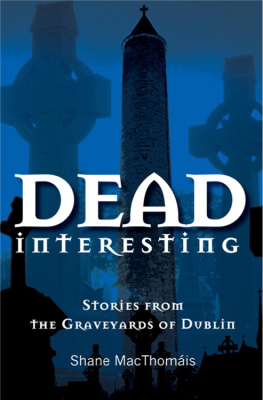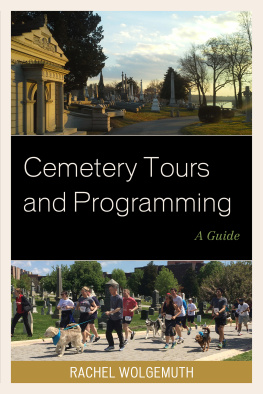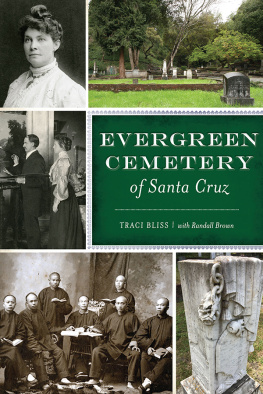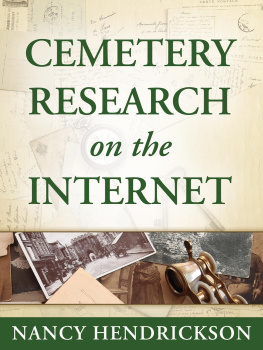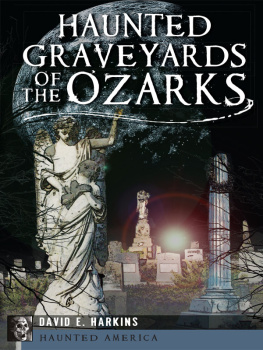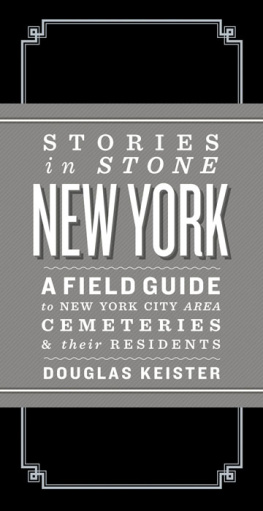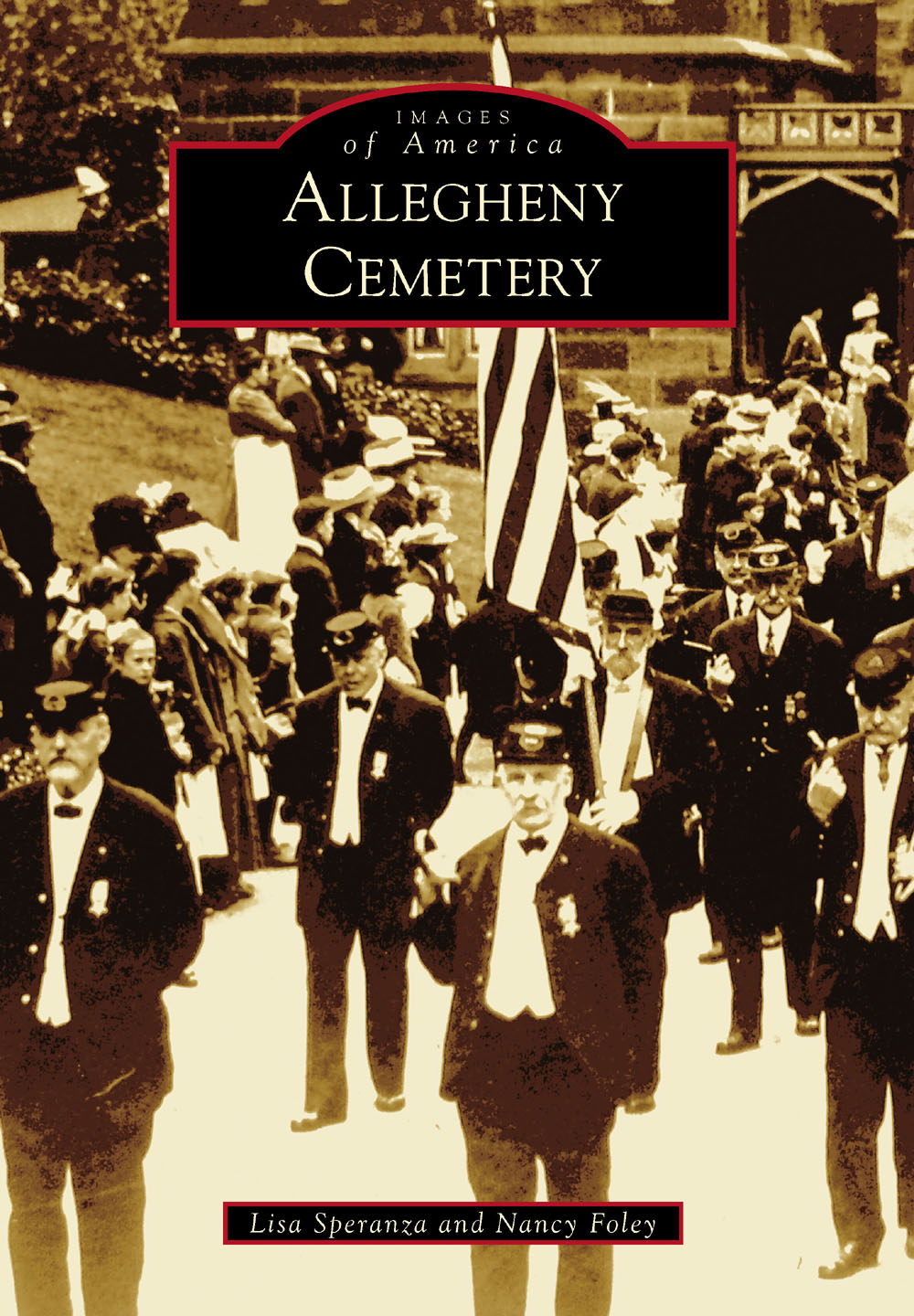
IMAGES
of America
ALLEGHENY
CEMETERY

BUTLER STREET GATEHOUSE, C. 1873. Shown here in an 1873 cemetery publication, the Butler Street Gatehouse appears much as it does today. Added only three years before this photograph was taken, the portion of the building featuring the clock tower was a secondary addition to the first section of the gatehouse, which was built when the cemetery originally opened. In 1848, the stone gate screen and gate keepers lodge (Porters House) were developed in the Early Gothic Revival style. In 18681870, the complex was enlarged to include a two-story stone building with a chapel, administration offices, and the clock tower. The latter addition was designed by Henry Moser of the firm Barr & Moser in the style of 19th century Romantic Picturesque architecture. While built at varying times, these structures flow seamlessly and stand as a testament to both the aesthetic quality and durability of the craftsmanship. (AC.)
ON THE COVER: MEMORIAL DAY 1918. Pittsburghs Memorial Day tradition began as early as 1872. Surviving Union veterans, as members of the Grand Army of the Republic, organized and led the original processions down Butler Street and into the cemetery, where a memorial service with full military honors was held in Section 33, where the Soldiers Memorial now stands. (AC.)
IMAGES
of America
ALLEGHENY
CEMETERY
Lisa Speranza and Nancy Foley

Copyright 2016 by Lisa Speranza and Nancy Foley
ISBN 978-1-4671-1738-8
Ebook ISBN 9781439658932
Published by Arcadia Publishing
Charleston, South Carolina
Library of Congress Control Number: 2016932608
For all general information, please contact Arcadia Publishing:
Telephone 843-853-2070
Fax 843-853-0044
E-mail
For customer service and orders:
Toll-Free 1-888-313-2665
Visit us on the Internet at www.arcadiapublishing.com
The authors humbly dedicate this book in loving memory of every person at rest in Allegheny Cemetery. To quote George Thornton Flemings 1919 introduction to his Life and Letters of Alexander Hays, Above the dust of the beloved dead, who passed to immortality this way, we bare our head and reverently tread, and tenderly our heartfelt homage pay.
CONTENTS
ACKNOWLEDGMENTS
The authors wish to acknowledge the love and support of their families and friends. Thank you to Nancys husband and constant companion, Stephen Foley, who is the light of her life and inspiration in all things. A heartfelt thanks to Nancys mother, Deborah Craigo, and aunt Barbara Held, who have both served Allegheny Cemetery loyally and who keep the Tiso and Held family histories alive and well. Lisa wishes to express her most sincere and humble appreciation for her familys endless hours of listening to stories about people they never met. She is incredibly grateful for her treasured daughter Becca and her love and support through countless hours of research. Lisa also wishes to thank her mother, Catherine, for constantly reiterating who was in the family plot until it finally clicked (well, mostly). Lastly, Lisa wishes to thank Grampy for his patience and enthusiasm and assures him he may now enjoy the stories he has so anxiously awaited.
A very special thanks to cemetery treasurer James M. Edwards, longtime director of Allegheny Cemetery and ardent supporter of all things historic, whose friendship, encouragement, and detailed research we have found invaluable. Allegheny Cemetery superintendent Roger Galbraith deserves our heartfelt thanks for his tireless service to the cemetery and helpfulness to the authors in too many capacities to be listed here.
The authors wish to recognize, with deep admiration, the efforts of the board of directors of Allegheny Cemetery, its chairman, Torrence M. Hunt Jr.; president, David J. Michener; and the management and staff of each department for their dedicated work as stewards and guardians of this priceless national treasure. Harmar D. Denny IV deserves our sincere thanks for his leadership as president and chairman of the board of the Allegheny Cemetery Historical Association.
Several people have endeared themselves to the authors during this process with their kind support and willingness to share precious family photographs and oral histories that greatly enhanced this work. For their assistance and the immediacy of their friendship, the authors humbly thank Frank and Kathy Eaton and Emanuel Ecker V. Nancy Janda and J. Dustin Williams provided wonderful images from the Hunt Institute for Botanical Documentation at Carnegie Mellon University.
The authors also acknowledge, with appreciation, the community and those who purchase this book, as it is only by sharing these stories that each person within lives on in the memory of generations yet to come.
Image sources have been credited as follows: Allegheny Cemetery (AC), Nancy Foley (NF), Lisa Speranza (LS), the Library of Congress (LOC), and Archive Service Center (ASC).
INTRODUCTION
On the western slope of the Allegheny Mountains, about three miles northeast of where its namesake river meets the Monongahela to form the great Ohio, nestled right in the heart of the urban neighborhoods of Lawrenceville, Bloomfield, Garfield, and Stanton Heights, lies a spectacular historic landscape, hiding in plain sight.
There are lakelets here, winding country paths, forested hillsides that climb beyond vision, expanses of lush green lawns adorned with flower beds and ornamental grasses, secluded ravines flanked by steep ridges offering stunning views of downtown, and, on clear winter days, the Allegheny River. In sylvan splendor it stands alone. Treesseveral thousand of them, many rare or exotic to the regionpopulate this urban oasis. Their ancient roots, as thick as trunks themselves, penetrate deep into the earth to intercept and absorb rainfall, control groundwater, and offer natural flood protection during storms. There are cool caves of shale where foxes escape the summer heat, leave tiny paw-print paths in winters snow, and curious cubs emerge each spring. On summer mornings, the canopy reverberates with the sound of unseen songbirds, their melodies composed before the dawn of man. A purposeful harmony with nature suits Alleghenys identity as a rural cemeterya curiously modern concept arising during the Romantic period of the mid- to late 19th century.
Initial interest in dedicating a parcel of land outside the city began in 1834 when sanitary and ethical concerns arose in response to overcrowded graveyards connected to churches. For Dr. James Ramsey Speer, Stephen Colwell, and noted architect John Chislett (all members of the Third Presbyterian Church, whose yard was a prime example of this issue), the establishment of a rural cemetery was deemed not only fundamentally necessary, but also culturally meaningful. The cemeterys charter members were of fine old Pittsburgh families who settled here during the Colonial era and were invested personally in the growth of the city and its environs. As these men already had a hand in establishing and expanding what was quickly becoming a bustling metropolis, they felt it proper that a City of the Dead ought, likewise, to be planned. After touring Mount Auburn in Boston and later Laurel Hill in Philadelphia, Dr. Speer had firsthand examples of the benefits of a nonprofit, nondenominational rural cemetery, which he incorporated wholly into the establishment of Allegheny Cemetery in Pittsburgh, making it the sixth incorporated cemetery in America and the first of this kind west of the Alleghenies.
Next page


